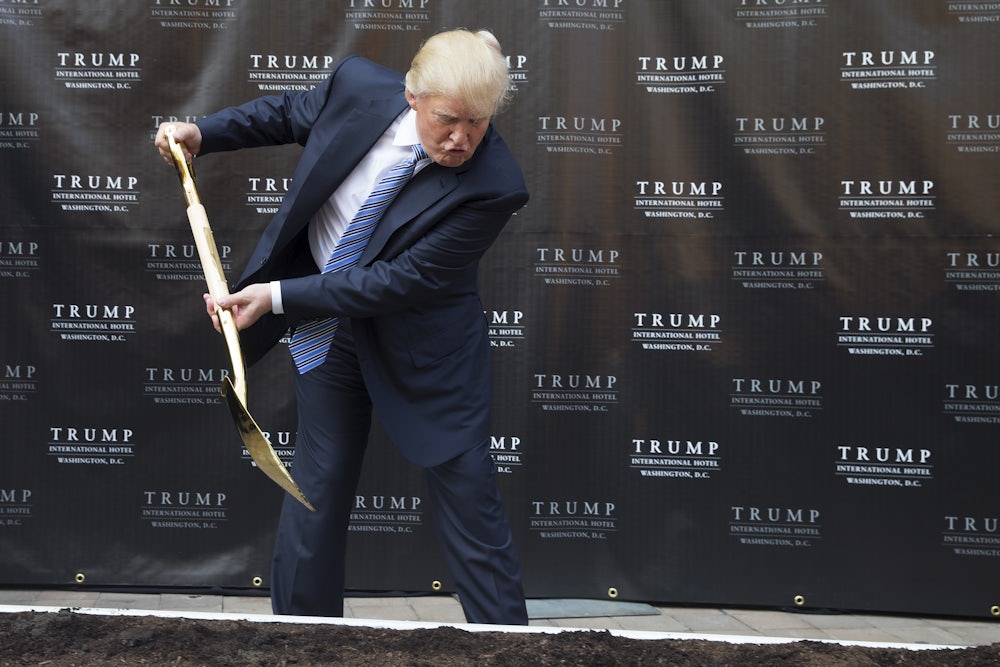Donald Trump campaigned on rebuilding America’s crumbling infrastructure. He’s governed on leaving it to rot. His proposed budget called for cutting federal spending on passenger rail and transit construction grants. Promised legislation to spend $1 trillion on roads and bridges, which in actuality seemed more like a scheme to privatize public assets, hasn’t materialized. And in a news dump just before the New Year’s holiday, Trump’s Federal Transit Administration nixed a deal for a second rail tunnel under the Hudson River between northern New Jersey and New York City’s Penn Station.
For more than a century, Amtrak and New Jersey Transit trains have flowed into the nation’s busiest rail hub through a pair of deteriorating tunnels, creating a debilitating bottleneck. The Obama administration, recognizing the critical need for new tunnels, agreed in late 2015 to bear half the costs for the $13 billion project and got buy-in from the affected states. But in a Friday letter, K. Jane Williams, deputy administrator at the Federal Transit Administration, delivered a fatal blow to the proposal, stating, “There is no such agreement.”
With tax cuts out of the way, Trump and the Republicans may turn to infrastructure again. “I’d like to see us pivot to infrastructure. We’ve talked it all year, the president talked about it,” Republican Senator Shelley Moore Capito told Politico last week. “I think it could be a bipartisan exercise.” The possibility that some Democrats might work with Trump on infrastructure makes some liberals nervous, as it risks turning the president into a bipartisan dealmaker rather than the object of resistance. But Republicans’ enduring actions on the nation’s most pressing public works project reveal the infrastructure promise as nothing but hollow rhetoric.
The new Hudson tunnels would enable the old ones to undergo critical repairs, which are seen as necessary within the next decade. The tunnels serve 85,000 commuters every day; if one were taken out of commission without a replacement, that number would have to fall to 21,000. This would create a very real crisis throughout the region, slashing Amtrak’s Northeast Corridor service between Boston and Washington as well as trips into Penn Station. “The economies of these cities are all completely connected together, so the travel up and down this corridor is critical to the economy of the United States,” Tom Wright, the president of the Regional Plan Association in New York, told NPR in 2015. “And it relies on these train lines under the Hudson River.”
A project of this magnitude requires the cooperation of New York, New Jersey, and the federal government. Back in 2010, New York and the Obama administration were on board with a plan called Access to the Region’s Core, or ARC. But New Jersey Governor Chris Christie killed the project, citing high costs. In actuality, Christie inflated the costs by $4 billion to justify his decision. He funneled money earmarked for the project into local transportation needs so he wouldn’t have to raise the state’s gas tax.
If Christie had given the green light back then, ARC would have been completed this year, according to estimates. In 2015, Christie consented to a new project called Gateway, after Obama’s Transportation Department upped the federal funding. But now, days before Christie is to be replaced by a Democratic governor, the remaining Republican left in the trio—Trump—has backed out.
The Federal Transit Administration claimed that the federal loans New York and New Jersey sought to pay their share of Gateway represented the administration’s monetary contribution to the tunnel. “The plan now seeks 100% of its funding from federal sources,” a Trump transportation official said—even though the states would repay the loans over time, with interest. Accessing low-interest federal loans is an incredibly normal way for states to finance infrastructure projects. If the Trump administration now sees these as federal outlays, then a lot of major projects are now in jeopardy.
There may be some political gamesmanship here. Senate Minority Leader Chuck Schumer is the biggest backer of Gateway in Washington, and also the one lawmaker needed to broker Democratic votes for a federal infrastructure bill. By holding Gateway hostage, Trump could be using it as a chip to get his deal through Congress. And it’s no secret that New York and New Jersey didn’t vote for Trump. Why should their residents have a functioning way to get to work?
But the history of the Hudson tunnel project, which always seems to die upon contact with a Republican, suggests that the GOP overstates its willingness to spend money on public works. Trump has pulled out of other infrastructure partnerships, like a plan to rebuild the Howard Street Tunnel at the Port of Baltimore. Trump’s proposed infrastructure bill would use tax cuts to induce private developers to kick in 80 percent of the $1 trillion cost. The developers would recoup their investments with tolls and user fees, comprising a wealth transfer from drivers and transit riders to wealthy investors.
It’s not just infrastructure. Any spending that doesn’t reward conservative donors and disproportionately benefit the rich—as the tax law does—is met with extreme reluctance, if not rejection. You can go down the line, from the shocking delay in reauthorizing the Children’s Health Insurance Program to growing chatter about partisan welfare reform in the new year. Republicans simply don’t want to pay out to anyone who doesn’t support their political project. A few Democrats might want to make a deal with Trump on infrastructure, in the hopes of having a concrete accomplishment to bring home to constituents before the midterm elections. But there’s really no deal to be made, if it requires Republicans to authorize money to improve ordinary people’s lives.
